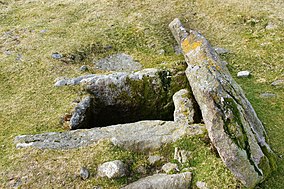| Dartmoor | |
|---|---|
 Kistvaen in Drizzlecombe on Dartmoor in South Devon, UK. The cap stone (which was originally used to seal the tomb) has been upended, and can be seen on the right of the image, behind the box-like structure of the cist. | |
| Location | Devon, England, United Kingdom |
| Coordinates | 50°34′N 4°0′W / 50.567°N 4.000°W |
| Area | 954 km2 (368 sq mi) |
| Established | 1951 |
| Visitors | 10.98m |
| Governing body | Dartmoor National Park Authority |
| Website | www |
Dartmoor kistvaens are burial tombs or cists from the late Neolithic and early Bronze Age, i.e. from c. 2500 BC to c. 1500 BC.[1] Kistvaens have been found in many places, including Dartmoor, a 954 km2 (368 square miles) area of moorland in south Devon, England. The box-like stone tombs were created when the ancient people of the area lived in hut circles. Cists are often to be found in the centre of a cairn circle although some appear solitary which could be the result of the loss of an original slight mound.[2] There are over 180[3] known cists on Dartmoor although there could be up to 100 that remain buried underneath unexplored cairns.[4] In the South West there are no cists to be found on the Quantock Hills, only 2 to be found on Exmoor and 58 to be found on Bodmin Moor.[3] The Dartmoor cists are unique in that about 94% have the longer axis of the tomb orientated in a NW/SE direction[5][6] It appears that Dartmoor cists were positioned in such a way that the deceased were facing the Sun.[7]
In August 2011 an untouched cist, on Whitehorse Hill, near Chagford, was the first to be excavated on the moor for over 100 years.[8] This burial yielded some rare Bronze Age artefacts made of organic materials.[9]
- ^ Newman, Phil (2011). The Field Archaeology of Dartmoor. Frome: English Heritage. ISBN 978-1-84802-033-7.
- ^ Butler, Jeremy (1997). Dartmoor Atlas of Antiquities: Vol. 5. – The Second Millennium B.C. Tiverton: Devon Books. ISBN 0861149106.
- ^ a b Newman 2011, p. 51.
- ^ Of the cairns excavated by the Dartmoor Exploration Committee 12% contained buried cists which would suggest around 100 cists remain concealed, Butler 1997, p. 173.
- ^ Worth, R. N. (1967). Spooner, G. M.; Russell, F. S. (eds.). Worth's Dartmoor. Newton Abbot: David & Charles. ISBN 0715351486.
- ^ Butler 1997 p.176
- ^ Cite error: The named reference
The Reliquary & illustrated archæologistwas invoked but never defined (see the help page). - ^ "Prehistoric burial chamber on Dartmoor excavated". Archaeology Daily News. 10 August 2011. Archived from the original on 29 March 2012. Retrieved 20 August 2011.
- ^ Jones, Andy. "'The Whitehorse Cist, Dartmoor'". Historic England Research. 7: 31–35.
